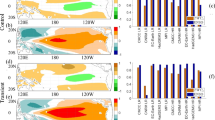Abstract
With the observational wind data and the Zebiak-Cane model, the impact of Madden-Julian Oscillation (MJO) as external forcing on El Niño–Southern Oscillation (ENSO) predictability is studied. The observational data are analyzed with Continuous Wavelet Transform (CWT) and then used to extract MJO signals, which are added into the model to get a new model. After the Conditional Nonlinear Optimal Perturbation (CNOP) method has been used, the initial errors which can evolve into maximum prediction error, model errors and their join errors are gained and then the Niño 3 indices and spatial structures of three kinds of errors are investigated. The results mainly show that the observational MJO has little impact on the maximum prediction error of ENSO events and the initial error affects much greater than model error caused by MJO forcing. These demonstrate that the initial error might be the main error source that produces uncertainty in ENSO prediction, which could provide a theoretical foundation for the adaptive data assimilation of the ENSO forecast and contribute to the ENSO target observation.
Similar content being viewed by others
References
Chen D, Cane M A, Kaplan A, et al. 2004. Predictability of El Niño over the past 148 years. Nature, 428(6984): 733–736
Chen D, Cane M A. 2007. El Niño prediction and predictability. J Comput Phys, 227(7): 3625–3640
Cravatte S, Picaut J, Eldin G. 2003. Second and first baroclinic Kelvin modes in the equatorial Pacific at intraseasonal timescales. J Geophys Res, 108(C8), doi: 10.1029/2002JC001511
Duan Wansuo, Liu Xinchao, Zhu Keyun, et al. 2009a. Exploring the initial errors that cause a significant “spring predictability barrier” for El Niño events. J Geophys Res, 114(C4), doi: 10.1029/2008JC004925
Duan Wansuo, Xue Feng, Mu Mu. 2009b. Investigating a nonlinear characteristic of El Niño events by conditional nonlinear optimal perturbation. Atmos Res, 94(1): 10–18
Duan Wansuo, Zhang Rui. 2010. Is model parameter error related to a significant spring predictability barrier for El Niño events? Results from a theoretical model. Advances in Atmospheric Sciences, 27(5): 1003–1013
Huang R H. 1999. Advance of the studies of the characteristics, cause of formation and prediction study for climate disaster in China. Chinese Academy of Sciences Bulletin (in Chinese), 3: 188–199
Kessler W S, Kleeman R. 2000. Rectification of the MJO into the ENSO cycle. J Climate, 13: 3560–3575
Luo Jingjia, Masson S, Behera S K, et al. 2008. Extended ENSO predictions using a fully coupled ocean-atmosphere model. J Climate, 21(1): 84–93
Moore A M, Kleeman R. 1996. The dynamics of error growth and predictability in a coupled model of ENSO. Quarterly Journal of the Royal Meteorological Society, 122(534): 1405–1446
Mu Mu, Sun Liang, Dijkstra H A. 2004. The sensitivity and stability of the ocean’s thermohaline circulation to finite amplitude perturbation. J Phys Oceanogr, 34(10): 2305–2315
Mu Mu, Duan Wansuo, Wang Bin. 2007a. Season-dependent dynamics of nonlinear optimal error growth and El Niño-Southern Oscillation predictability in a theoretical model. J Geophys Res, 112(D10), doi: 10.1029/2005JD006981
Mu Mu, Xu Hui, Duan Wansuo. 2007b. A kind of initial errors related to “spring predictability barrier” for El Niño events in Zebiak-Cane model. Geophysical Research Letters, 34(3), doi: 10.1029/2006GL027412
Mu Mu, Jiang Zhina. 2008. A new approach to the generation of initial perturbations for ensemble prediction: Conditional nonlinear optimal perturbation. Chinese Sci Bull, 53(13): 2062–2068
Mu Mu, Zhou Feifan, Wang Hongli. 2009. A method for identifying the sensitive areas in targeted observations for tropical cyclone prediction: conditional nonlinear optimal perturbation. Mon Wea Rev, 137(5): 1623–1639
Peng Yuehua, Duan Wansuo, Xiang Jie. 2011. Effect of stochastic MJO forcing on ENSO predictability. Advances in Atmospheric Sciences, 28(6): 1279–1290
Peng Yuehua, Duan Wansuo, Xiang Jie. 2012. Can the uncertainties of Madden-Jullian Oscillation cause a significant “spring predictability barrier” for ENSO events?. Acta Meteorologica Sinica, 26(5): 566–578
Rong Xinyao, Zhang Renhe, Li T. 2011. Upscale feedback of high-frequency winds to ENSO. Quarterly Journal of the Royal Meteorological Society, 137(657): 894–907
Slingo J M, Rowell D P, Sperber K R, et al. 1999. On the predictability of the interannual behaviour of the Madden-Julian oscillation and its relationship with E1 Niño. Quarterly Journal of the Royal Meteorological Society, 125(554): 583–609
Su Tonghua, Xue Feng, Sun Hongchuan, et al. 2015. The El Niño-Southern Oscillation cycle simulated by the climate system model of Chinese Academy of Sciences. Acta Oceanologica Sinica, 34(1): 55–65
Tang Youmin, Deng Ziwang, Zhou Xiaobing, et al. 2008. Interdecadal variation of ENSO predictability in multiple models. J Climate, 21(18): 4811–4833
Xie Qiang, Wu Xiangyu, Yuan Wenya, et al. 2007. Life cycle of intraseasonal oscillation of summer SST in the western South China Sea. Acta Oceanologica Sinica, 26(3): 1–8
Zebiak S E, Cane M A. 1987. A model El Niño-Southern Oscillation. Mon Wea Rev, 115(10): 2262–2278
Zebiak S E. 1989. On the 30-60 day oscillation and the prediction of El Niño. J Climate, 2(11): 1381–1387
Zhang Chidong. 2001. Intraseasonal perturbations in sea surface temperatures of the equatorial eastern Pacific and their association with the Madden–Julian Oscillation. J Climate, 14(6): 1309–1322
Zhang Renhe, Zhou Guangqing, Chao Jiping. 2003. On ENSO dynamics and its prediction. Chinese Journal of Atmospheric Sciences (in Chinese), 27(4): 674–688
Author information
Authors and Affiliations
Corresponding author
Additional information
Foundation item: The National Natural Science Foundation of China under contract No. 41405062.
Rights and permissions
About this article
Cite this article
Peng, Y., Song, J., Xiang, J. et al. Impact of observational MJO forcing on ENSO predictability in the Zebiak-Cane model: Part I. Effect on the maximum prediction error. Acta Oceanol. Sin. 34, 39–45 (2015). https://doi.org/10.1007/s13131-015-0665-0
Received:
Accepted:
Published:
Issue Date:
DOI: https://doi.org/10.1007/s13131-015-0665-0




